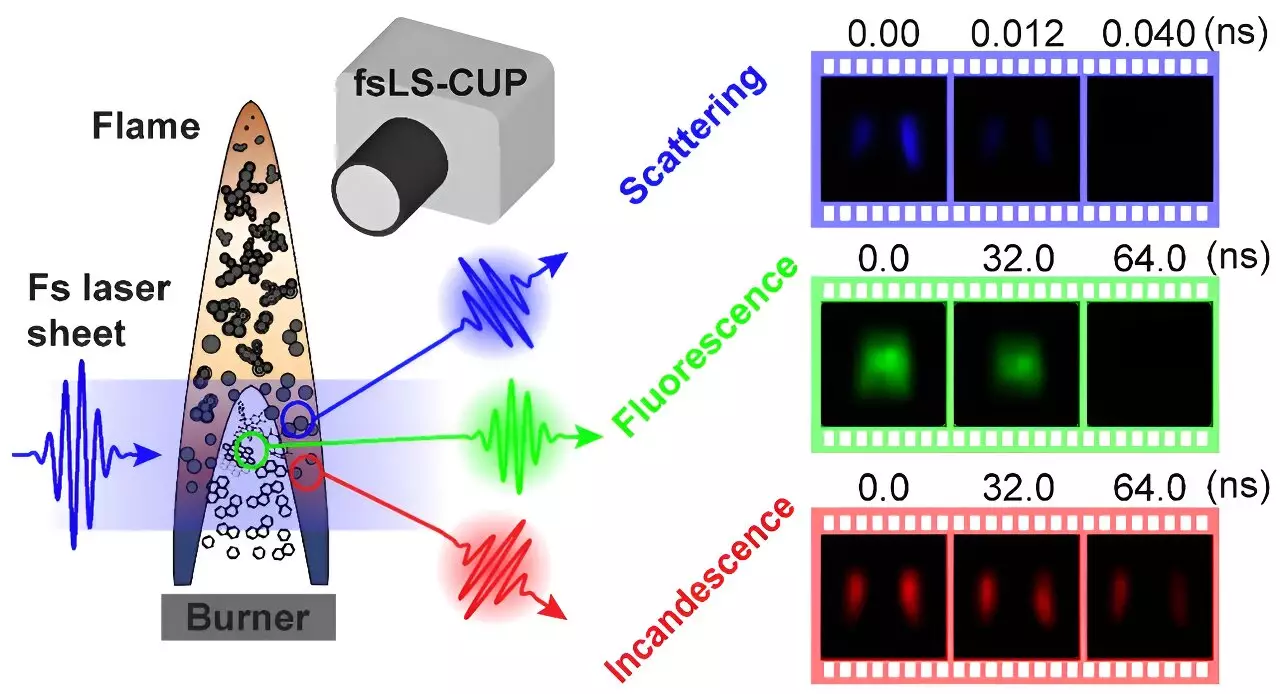In recent years, the study of combustion dynamics and particle formation has emerged as a focal point for researchers aiming to understand environmental impacts and energy generation. Among the most significant players in this arena are polycyclic aromatic hydrocarbons (PAHs) and soot particles—a byproduct commonly found in airplane engines and combustion processes. These carbon-based substances are not only harmful to human health and the environment, but they also provide important insights into both interstellar chemistry and the technological advancements in electronics and sustainable energy. However, studying the behavior and properties of PAHs and soot particles presents a formidable challenge due to their fleeting existence, which often lasts mere billionths to millionths of a second.
Traditional imaging techniques have struggled to portray the rapid changes occurring during combustion events. The imaging systems available until now can only capture a few million frames per second, often resulting in the need for multiple laser pulses that may lead to unintended heating effects. Furthermore, conventional methods usually rely on capturing repeated events and stitching images together to form a cohesive representation of fast dynamics, making these approaches inefficient and limited. As scientists seek to explore the microcosm of rapid chemical reactions, the demand for innovative imaging technologies has grown, prompting researchers to develop unprecedented solutions.
A remarkable innovation has recently emerged from a collaborative effort led by Dr. Yogeshwar Nath Mishra, Dr. Peng Wang, Dr. Murthy S. Gudipati, and Professor Lihong V. Wang at the California Institute of Technology. Their research introduced a game-changing technique known as femtosecond laser sheet-compressed ultrafast photography (fsLS-CUP). This new method represents a quantum leap in camera technology, achieving a staggering 250 billion frames per second, making it 20,000 times faster than existing systems. By employing a single femtosecond laser pulse, fsLS-CUP offers simultaneous imaging of laser-induced fluorescence from PAHs, heating effects from soot, and elastic light scattering resulting from particle interactions.
The potential of this technology extends far beyond mere imaging; it enhances our fundamental understanding of combustion processes and contributes significantly to a variety of scientific disciplines. As Dr. Mishra eloquently stated, this novel imaging technique opens up new pathways for exploring the science of hydrocarbon and nanoparticle formation, bridging gaps in our knowledge of the universe’s origins.
The versatile capabilities of fsLS-CUP transcend combustion research, with implications for multiple scientific fields such as physics, chemistry, biology, medicine, energy, and environmental science. Dr. Peng Wang noted that the method’s high-speed imaging enables scientists to observe rapid natural phenomena that were previously beyond reach. The 2D imaging capability of fsLS-CUP captures intricate details, enhancing spatial and temporal resolution in studies of laser-induced signals from soot and PAHs.
The technology exemplifies the innovative shifts in imaging performance, showcasing the importance of continuous evolution and interdisciplinary collaboration in addressing complex scientific questions. The fsLS-CUP method also employs compressed sensing techniques, providing a wide field of view while simultaneously resolving spatial and temporal details in real-time.
The study led by this research team has notable ramifications for astrobiology and understanding the formation of PAHs and soot in astrophysical contexts. Dr. Murthy S. Gudipati’s research on PAHs, which are potent molecules present in interstellar mediums, indicates the crucial role they play in understanding cosmic conditions. The formation of these molecules in environments like carbon-rich asymptotic giant branch stars holds strong potential for elucidating their existence and behaviors under extreme astrophysical conditions.
The advent of femtosecond laser sheet-compressed ultrafast photography represents a significant milestone in the field of imaging technology, providing unparalleled insights into rapid scientific phenomena. As researchers continue to leverage the remarkable capabilities of fsLS-CUP, the potential for groundbreaking discoveries is vast. The combined expertise of the contributors to this research not only paves the way for advancements in combustion science, but also furthers our understanding of fundamental chemical processes and their applications across various fields. The future holds promise as scientists delve deeper into transient phenomena, propelled by the innovative strides ushered in by fsLS-CUP technology.

